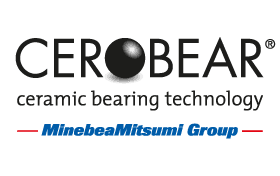LDPE & EVA Production
LDPE & EVA Production
The first LDPE/EVA (Low Density Polyethylene / Ethylene Vinyl Acetate) autoclave process was introduced in 1938. In this type of application, a mix of pressurized ethylene gas and catalysts is stirred at high temperature in a vessel. The stirrer is turned by an electric motor which is in line with the vessel. The operating pressure in a range of 1300 – 3500 bar, the process temperature varies between 100 – 300 degrees Celsius.
As the bearings of the stirrer and the motor have to be operate in the pressurized zone, they can be lubricated by the incoming ethylene gas or the reacted product only. Under these compromised lubrication conditions, conventional bearings suffer adhesive wear after very short time and have therefore been the weak link in the machinery from the start of this technology. This situation was changed to the better with the introduction of CEROBEAR hybrid ceramic ball and roller bearings in 1998. As hybrid ceramic bearings do not suffer adhesive wear due to the inertness of Si3N4 ceramic, the bearing damage related service life of reactors using this advanced bearing technology could be increased by factor 4 to 8, depending on the operating conditions. The arrival of the new bearing technology helped manufacturers to cut downtime, production loss and maintenance costs dramatically.
CEROBEAR rolling bearings for the use in high pressure autoclaves for the production of LDPE or EVA contain rollers or balls made of Si3N4 ceramic and rings made of High-Nitrogen-Steel Cronidur 30 (HNS, 1.4108 or X30 CrMoN 15 1), M50 (AMS 6491) tool steel or powder metallurgical steel.
The Si3N4 ceramic is a chemically inert and very hard (1550 HV) material, which offers an about 40% lower friction coefficient compared to standard bearing steel. In addition the inert properties prevent adhesive wear between rolling element and raceway during dry running or media lubrication. Furthermore the low friction and low surface roughness of CEROBEAR ceramic rolling elements (even after several thousand hours of operation) reduce cage wear to a minimum. Depending on the operating temperatures brass or aluminum bronze are used as the cage materials, which in combination with Si3N4 rolling elements function excellently and hardly wear out. As the last component the rings are made of higher grades of bearing steels than conventional rolling bearings (100Cr6 (SAE 52100) or AISI 440C). The High-Nitrogen-Steel Cronidur 30 (HNS, 1.4108 or X30 CrMoN 15 1) offers excellent resistance to corrosion, wear and fatigue. As an alternative CEROBEAR also offers the tool steel M50 or powder metallurgical steel, which provide a higher hardness (especially a higher hot hardness) compared to Cronidur and thus a better wear resistance. However the disadvantage of these two materials is their lower corrosion resistance compared to HNS. In addition to the higher grades of materials the rings are also provided with a WC/C coating, which serves as a kind of solid lubricant and therefore further reduces friction and wear on the bearings.
As a result of these high-quality material combinations CEROBEAR hybrid bearings can be operated under poor lubrication conditions, high temperatures and high pressures and thus increase the overall service life of high-pressure autoclaves multiple times.
CEROBEAR works worldwide directly with LDPE and EVA manufacturers as well as with licensors and reactor OEMs. The typical approach is to replace conventional bearings by CEROBEAR hybrid bearings with superior bearing steels as a one to one replacement. In a next step CEROBEAR experts analyze the wear pattern of a set of used hybrid bearings to recommend improvements of the internal bearing design to further increase bearing performance.
Due to the superior service life of CEROBEAR hybrid and all-ceramic bearings and thus the reduction of the total cost of ownership, the world´s leading LDPE producing companies trust in CEROBEAR´s products and services for more than 20 years now.


